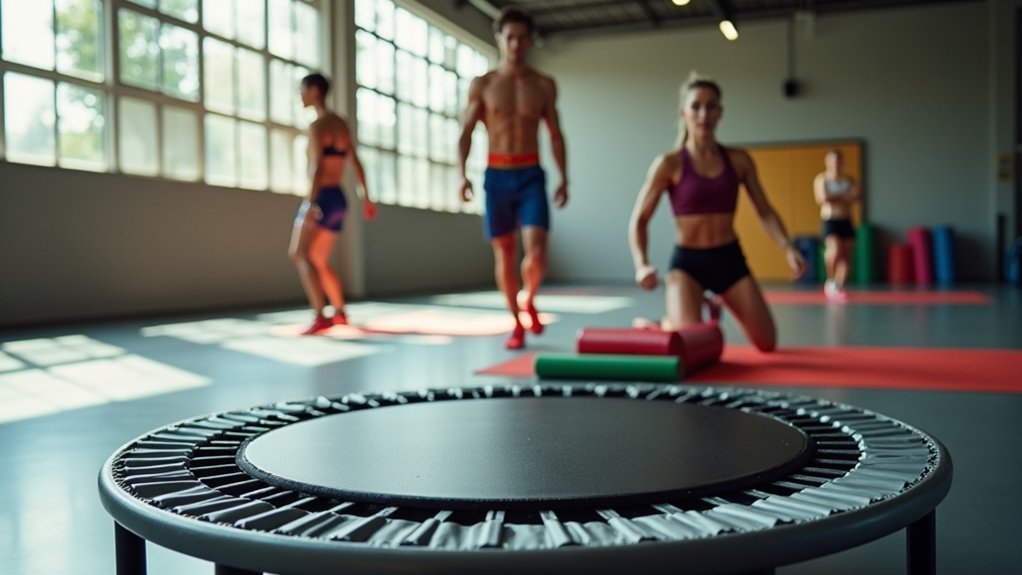Elite athletes incorporate mini-trampolines daily because they enable full-body training with 80% less joint stress compared to running. You’ll reach 79% of your maximum heart rate while using only 59% oxygen consumption, making workouts more efficient—10 minutes of rebounding equals 30 minutes of running. These devices enhance recovery by improving lymphatic drainage, flushing lactic acid, and promoting mitochondrial development. Discover why this simple tool transforms both training intensity and recovery effectiveness.
Why Elite Athletes Choose Mini-Trampolines Daily

While traditional training equipment dominates gym floors, elite athletes increasingly turn to mini-trampolines as vital daily training tools.
These versatile platforms deliver full-body activation, targeting multiple muscle groups simultaneously while enhancing kinesthetic awareness through constant balance challenges.
Mini-trampolines engage your entire muscular system while constantly challenging positional awareness through dynamic instability.
You’ll experience significant performance gains without the joint stress of high-impact surfaces. Mini-trampolines increase bone density while reducing injury risk—improving balance recovery speed by up to 35%.
They optimize recovery by flushing lactic acid and enhancing circulation, letting you train harder with shorter downtime between sessions. Research shows that regular rebounding contributes to stress relief through endorphin release during workouts.
The coordination benefits are equally impressive, sharpening reaction time and spatial awareness essential for precision sports.
Your cardiovascular system benefits too, with efficient heart rate elevation and sustained rhythmic exertion that complements high-intensity protocols without overtaxing your body.
The Science Behind Rebounding’s Cardiovascular Efficiency
Although traditional cardio exercises dominate training programs, mini-trampoline rebounding delivers superior cardiovascular benefits through unique physiological mechanisms. Your heart reaches 79% of maximum rate during rebounding sessions while requiring only 59% of maximum oxygen consumption—optimal efficiency backed by ACSM guidelines. Studies have revealed that mini-trampoline workouts are highly enjoyable for participants, leading to better long-term exercise adherence.
| Rebounding Impact | Your Physiological Response |
|---|---|
| Increased red blood cell count | Better oxygen delivery to muscles |
| 80% reduced joint stress | Sustainable long-term training |
| Enhanced cardiac stroke volume | Lower resting heart rate |
| Time efficiency | 10 minutes equals 30 minutes of running |
You’ll experience faster entry into target heart rate zones with less perceived exertion, while the trampoline’s elastic surface minimizes impact forces. This creates ideal conditions for cardiovascular adaptations without the joint wear that typically accompanies high-intensity training.
Progressive Stamina Building Through Interval Rebound Training

As elite athletes constantly seek training methods that maximize results while minimizing wear and tear, interval rebound training represents the perfect synthesis of intensity and preservation.
You’ll experience physiological adaptations unique to trampoline work—expanded aerobic capacity, elevated lactate thresholds, and enhanced respiratory efficiency. The 30:60 work-to-rest protocol creates ideal stress-recovery balance while the dynamic surface forces continuous neuromuscular adjustments. Regular trampoline sessions provide cardiovascular fitness benefits that translate to sustained performance over extended competitive seasons.
Your progression path is clear: begin with shorter high-intensity phases (15 seconds), gradually extending to 60 seconds while layering in complexity through arm movements and rotational elements. This incremental approach guarantees sustainable stamina gains without the joint microtrauma of traditional surfaces.
The carryover to sport-specific movements is immediate—improved multiplanar stability, enhanced elastic energy utilization, and precise foot-strike mechanics translate directly to competitive performance.
Oxygen Uptake Enhancement During Sustained Mini-Trampoline Sessions
Your body’s oxygen transportation system works more efficiently during mini-trampoline sessions that reach 35-69% of peak VO₂ levels common in endurance training.
You’ll improve your VO₂ max with just three 20-30 minute weekly sessions, as evidenced by clinical trials showing significant oxygen uptake enhancements across diverse populations.
The trampoline’s elastic surface allows you to maintain ideal intensity within ACSM-recommended heart rate zones (64-94% HRmax) while experiencing less perceived exertion than ground-based exercises. The research demonstrates that mini trampoline workouts can serve as an effective workout option for both endurance-trained athletes and overweight-obese individuals alike.
Cellular Oxygen Transport
When athletes engage in sustained mini-trampoline sessions, their bodies experience remarkable enhancements in cellular oxygen transport mechanisms. The rhythmic bouncing creates alternating pressure gradients that improve circulation while the g-force variations stimulate capillary expansion, directly enhancing oxygen delivery to working muscles.
Your cells benefit in three distinct ways:
- Mitochondrial activity increases through enhanced oxygen availability, optimizing ATP production during continuous rebounds.
- Intercostal muscle activation improves respiratory efficiency while reducing oxygen diversion to impact absorption.
- Improved lactate clearance occurs through combined lymphatic flow and oxygenation effects.
Unlike conventional training, mini-trampolines create these benefits while preserving joint integrity, allowing you to train more frequently. As demonstrated in the ACE-sponsored study, a 20-minute workout on a rebounder delivers caloric expenditure equivalent to 30 minutes of jogging.
This unique combination of reduced stress and enhanced cellular oxygen transport explains why elite athletes incorporate these devices into their daily routines.
VO2 Max Improvement
The remarkable VO2 max improvements from mini-trampoline training stem from its unique combination of high-intensity aerobic stimulus and reduced joint impact. You’ll achieve 70-85% HRmax while sparing your joints, enabling longer sustained high-effort intervals than traditional cardio.
Studies confirm 4.4-7.8% VO2max gains from just 3 weekly sessions over 8-11 weeks—superior to jogging at matched intensities.
The unstable surface engages whole-body proprioception, increasing metabolic demands beyond treadmill workouts.
Your body adapts through increased stroke volume, mitochondrial biogenesis, and optimized venous return from rhythmic gravitational cycles. The reduced perceived exertion keeps you training consistently, while the multidirectional movements enhance oxygen utilization at the cellular level through neuroendocrine activation. The standardized jumping-fitness training significantly improved running speed at V4 in intervention group participants compared to controls.
Recovery-Based Endurance Protocols for High-Performance Athletes

High-performance athletes often struggle to maintain adequate recovery while building endurance capacity, which is why mini-trampolines have emerged as invaluable tools in recovery-based protocols. They reduce joint stress through shock absorption during high-repetition conditioning while maintaining sustained aerobic output without damaging ground reaction forces.
Mini-trampolines provide elite athletes the perfect balance of joint protection and cardiovascular training without sacrificing performance development.
When you integrate mini-trampolines into your recovery routine, you’ll experience:
- Enhanced lymphatic drainage – The vertical rebounding motion accelerates post-workout toxin clearance.
- Preserved neuromuscular patterns – Sport-specific skills maintain motor patterns without impact risks.
- Improved rehabilitation outcomes – Studies show 12-week trampoline programs deliver functional mobility improvements comparable to traditional rehab. Athletes report 41% higher confidence in their recovery journey when incorporating trampoline-based exercises into their rehabilitation protocols.
You’ll also develop fatigue resistance through rhythmic low-impact movement while maintaining training continuity with portable trampolines during travel periods.
Metabolic Adaptations From Long-Duration Rebounding Workouts
Your body’s metabolism transforms during long-duration rebounding workouts, greatly enhancing fat oxidation processes and overall caloric expenditure.
You’ll experience increased mitochondrial density in muscle cells, allowing for more efficient energy production and improved endurance capacity.
These cellular adaptations work together to optimize your metabolic rate, making mini-trampolines an effective tool for elite athletes seeking both performance and weight management benefits. However, athletes should be aware that significant weight loss may trigger metabolic adaptation, causing energy needs to drop more steeply than expected.
Optimized Fat-Burning Mechanisms
While traditional cardio methods receive most attention, elite athletes are discovering that long-duration rebounding workouts create unique metabolic adaptations that optimize fat-burning mechanisms.
You’ll benefit from the multi-muscle engagement that drives higher caloric expenditure while enjoying the low-impact nature that allows for extended training sessions.
Mini-trampoline workouts enhance your fat-burning potential through:
- Temporal adaptations that improve your body’s efficiency in utilizing fat stores as a primary energy source during extended exercise
- Increased metabolic flexibility that helps your body seamlessly switch between carbohydrate and fat utilization
- Enhanced circulatory benefits that optimize oxygen transport throughout your body, promoting more efficient metabolic processes
These adaptations translate to improved body composition with reduced fat mass and increased lean muscle—key metrics for elite performance. The afterburn effect continues to burn calories for hours after your rebounding session, making it an exceptionally efficient workout choice for athletes seeking optimal weight management.
Mitochondrial Density Increases
Elite athletes who engage in long-duration rebounding workouts experience significant increases in mitochondrial density, the powerhouses fueling cellular energy production.
This biogenesis process enhances your overall endurance capacity and energy availability long after your workout ends.
When you bounce consistently, you’ll trigger improved mitochondrial function through repetitive stress, optimizing cellular efficiency. Studies show rebounding is 68% more efficient than jogging, making it an ideal exercise for athletes seeking metabolic advantages.
Research shows that trampoline exercises specifically increase mitochondrial proteins and citrate synthase activity—key markers of improved oxidative capacity.
The vertical acceleration and deceleration unique to rebounding stimulates these adaptations more efficiently than traditional training.
In fact, sprint interval training on mini-trampolines is approximately 2.3 times more efficient than high-intensity training and 3.9 times more than endurance training for increasing mitochondrial content per exercise hour, regardless of muscle mass engaged.
Heart Rate Zone Training Strategies on Mini-Trampolines
As athletes increasingly turn to mini-trampolines for sophisticated training, understanding heart rate zone strategies becomes critical for enhancing performance benefits.
You’ll achieve precise cardiovascular targets through rebounding’s unique ability to modulate intensity with minimal joint stress.
The mini-trampoline excels at Zone 2 training (60-70% max HR), where your body maximizes fat oxidation while preserving glycogen stores. Unlike running, you can maintain this state longer due to reduced impact fatigue. This approach provides low impact on joints while still delivering effective cardiovascular conditioning.
- Adjust bounce height and cadence (80-120 bpm) to shift seamlessly between zones
- Structure 20-30 minute sessions for ideal Zone 2 conditioning, or stack multiple 10-minute bouts throughout the day
- Use vertical acceleration to enhance stroke volume through gravitational variance, improving cardiac efficiency
Frequently Asked Questions
How Do Mini-Trampolines Compare to Traditional Trampolines for Athletes?
Mini-trampolines offer you lower spring tension, controlled movements, and greater portability than traditional trampolines. They’re designed for precision training rather than height, making them ideal for daily strength and balance exercises.
Can Mini-Trampolines Help With Specific Sports Like Basketball or Tennis?
Yes, mini-trampolines boost your basketball vertical leap and strengthen calves for quick court movements. For tennis, they improve your agility, balance, and coordination – essential skills when moving rapidly across the court during matches.
What’s the Ideal Duration and Frequency for Effective Mini-Trampoline Workouts?
For effective mini-trampoline workouts, you’ll get ideal results with 20-30 minute sessions 3-5 times weekly. Add 10-15 minute daily sessions for recovery, and always include rest days to prevent injury and maximize benefits.
Are There Age Limitations for Athletes Using Mini-Trampolines?
No strict age limits exist for trampoline use. You’ll find benefits at any age, but you should adapt your training to your fitness level. Children need supervision, while seniors gain balance and bone density.
How Should Athletes Combine Mini-Trampoline Training With Other Workout Methods?
You should integrate mini-trampoline sessions as pre-workout warmups (10-15 minutes), post-strength cooldowns (5-10 minutes), or hybrid intervals alternating with weightlifting. Schedule 3-4 weekly sessions alongside your sport-specific training for balanced conditioning.
In Summary
You’re now equipped to join elite athletes who’ve discovered mini-trampolines’ power. You’ll maximize cardiovascular efficiency, build stamina through interval training, and enhance oxygen uptake with daily sessions. Whether you’re focusing on recovery-based protocols or metabolic adaptations, you’ve got a versatile tool that delivers results. Try heart rate zone training on your mini-trampoline and you’ll quickly understand why top performers won’t start their day without rebounding.





Leave a Reply